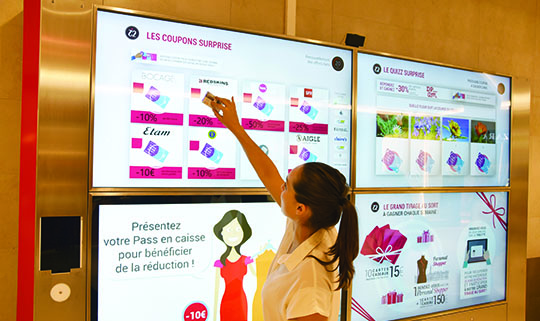Think unified shopping experience: Accepting multi-channel payment methods
January 14, 2019
Giving customers the choice of payment method, whenever and wherever they want, helping retailers drive business
SPECIAL FROM INGENICO
OMNICHANNEL has become one of the biggest buzzwords in the retail landscape. While the strategy is generically understood by retailers, executing on that vision has been far from simple. For many, meeting the expectations of today’s demanding consumer is seen as an overwhelming and complex task. And it helps explain why only 22 per cent of North American retailers consider omnichannel efforts a top priority.
Consumers neither understand nor care that they are traversing across digital and physical channels. The experience must be seamless and unified. Retailers need to become hyper-focused on what customers want from the shopping experience. When it comes to completing a purchase, 73 per cent of consumers report using multiple channels, and typically spend more when they do.
To properly engage their customers, retailers need to truly understand who their customers are. It is a dangerous misconception to put too much emphasis on moving everything online while ignoring what is actually happening in-store. Retailers need to think beyond the aisle, beyond the traditional payment methods, and beyond the payment itself, viewing all of it as equally important to the business. Think unified.
Beyond the aisle
There are many solutions available beyond the standard attended checkout, making it easy for retailers to get creative with their in-person payment options. Standalone kiosks have grown in popularity in recent years and provide a cost effective solution with increased speed and convenience for the consumer. The next evolution is the Ingenico Connected Screen. The Connected Screen bridges the gap between online and in-person. It allows consumers to browse, shop, and pay on a secure screen that can be found in-store, in a mall, or in a short-term pop-up location, making it simple for customers to pay quickly and be on their way. All without the need for a customer downloaded app. The screen accepts payment itself without the need for an external pin-pad.
If a more personal consumer experience is desired, retailers will want to look at adopting in-app payment solutions and online checkout options. Not only can consumers shop and pay with mobile apps and online checkout, these options also allow them to order ahead for products or services, pay via a secure checkout form, and then pickup their products in the physical store.
Retailers can also leverage mobile pointe of sale (mPOS) solutions to bring a more personalized checkout experience to the customer inaisle. With these solutions, associates can look up product details, upsell customers and then provide a seamless payment experience right from the point of interaction, which in turn helps capture impulse.
The future of in-store isn’t in peril, just in transition as brands start creating experiences to engage consumers. Smart brands know that the purchase may happen anywhere at any time. Getting loyalty through in-person experiences ensures the consumer continues to interact with the brand.
Beyond the traditional
One of the best ways for retailers to meet the ever-changing shopping needs of consumers, regardless of demographic, is to accept payments beyond the standard plastic card. While debit card and credit card purchases remain the most dominant payment method, contactless payments cannot be ignored. With an expected 450 million users by 2020, the mobile contactless payment market will account for 1 in 3 in-store transactions—a $2 trillion value.
To successfully implement new payment methods, retailers need to understand the time and effort required. By working with partners who can integrate the new capabilities quickly, with minimal impact to their existing infrastructure, retailers can go to market more quickly. These partners should also be consultative and provide insight into the coming trends before they are a necessity.
Understanding the payments ecosystem and the consumer’s desire to use new forms of payment is critical for retailers. You don’t want to lose customers if their preferred payment type isn’t offered. Maybe your customer wants to pay with a wearable such as an Apple Watch; with a digital wallet, such as Google Pay; or perhaps even QR code payment schemes like AliPay and WeChat. Whatever the customer has on them at the moment of purchase should be enough to make a sale, in-store and at home as well.
Beyond the payment
Payments is one of the fastest evolving industries worldwide. Keeping customers engaged during and beyond the purchase is the best way to gain their loyalty. Retailers have an abundance of insight into consumer buying behaviour. When you look at the customer journey through multiple channels you get a deeper understanding of how your customers shop and what they are looking for, so you can tailor your efforts towards the customer experience they desire.
Running the gathered customer insight through intelligent algorithms, retailers can develop targeted offers at any time of interaction regardless of where it takes place. Online intelligence does not have to be limited to only online engagements. The same can be said for in-store activities. Creating a complete profile of the consumer may convert a simple web-based page view one day into a purchasing opportunity the next time the consumer is near one of your retail locations. Sound farfetched? Not so. The data is there. It’s just a matter of putting all the pieces together.
PAYING FOR IT ON ALL CHANNELS
73%
73% – Percentage of Canadian consumers who report using multiple channels to shop.
450M
The estimated number of consumers leveraging mobile payments by 2020.
1 in 3
The estimated number of transactions the mobile payment market will account for by 2020, a $2 trillion value
Creating a seamless journey
To capture a customer’s attention, retailers need to think of shopping as a unified, seamless journey. Clearly, customers are engaging across multiple channels as part of their shopping experience. And retailers must respond accordingly. The moment a customer decides to make a purchase, they will expect to pay where, when, and how they want. All obstacles must be thoughtfully removed.
Retailers really need to understand who their customers are so they can enable the payment options they expect. It’s not about what everyone else is doing, it’s about creating the experience your customers want. Retailers who ignore this reality, do so at their own peril.



